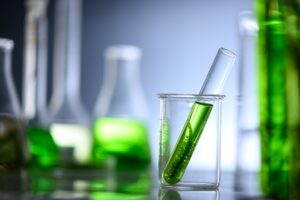The potential of algae as a source of biofuel has been recognized for many decades. However, the actual conversion process, from raw algae to usable biofuel, is a complex one that has been the subject of extensive research and development. Two primary methods of conversion exist: thermochemical and biochemical. Both have their own unique advantages and disadvantages, and the choice between them often depends on the specific characteristics of the algae being used.
Thermochemical conversion involves the use of heat to break down the algae into its constituent parts. This can be achieved through processes such as pyrolysis, gasification, or hydrothermal liquefaction. Pyrolysis involves heating the algae in the absence of oxygen to produce a bio-oil, which can then be further refined into biofuel. Gasification also uses heat but in the presence of a controlled amount of oxygen or steam, to convert the biomass into a synthetic gas (or syngas), which can then be converted into biofuel. Hydrothermal liquefaction, on the other hand, uses high temperature and pressure to convert the algae into a biocrude oil.
Biochemical conversion, by contrast, uses biological processes to convert the algae into biofuel. The most common of these is anaerobic digestion, in which microorganisms break down the algae in an oxygen-free environment to produce biogas. This biogas can then be cleaned and upgraded to produce biomethane, a renewable natural gas. Another biochemical method is fermentation, where certain types of yeast or bacteria are used to convert the sugars in the algae into ethanol.
Recent progress in biorefinery techniques have brought about significant improvements in both thermochemical and biochemical conversion methods. For instance, advancements in hydrothermal liquefaction have allowed for more efficient processing of wet algae biomass, eliminating the need for costly drying processes. Similarly, innovations in anaerobic digestion have led to increased methane yields and better nutrient recovery.
Hybrid systems that combine both thermochemical and biochemical processes are also being explored. These systems aim to maximize energy recovery by taking advantage of the strengths of both conversion methods. For example, a hybrid system might use gasification to convert the lignocellulosic fraction of the algae into syngas, while using anaerobic digestion to process the lipid-rich fraction into biomethane.
Despite these advancements, there are still challenges that need to be addressed. One major issue is the high energy requirement for some conversion processes, particularly those involving high temperatures or pressures. This not only increases costs but also impacts the overall sustainability of algae biofuel production.
Another challenge is dealing with contaminants that may be present in the algae biomass. These can interfere with conversion processes and reduce their efficiency. Research is ongoing to develop methods for effectively removing these contaminants without significantly increasing costs.
In conclusion, while significant progress has been made in improving algae biofuel conversion processes, there is still much work to do. Ongoing research and development are crucial to overcoming current challenges and making algae biofuels a viable and sustainable alternative to fossil fuels.

